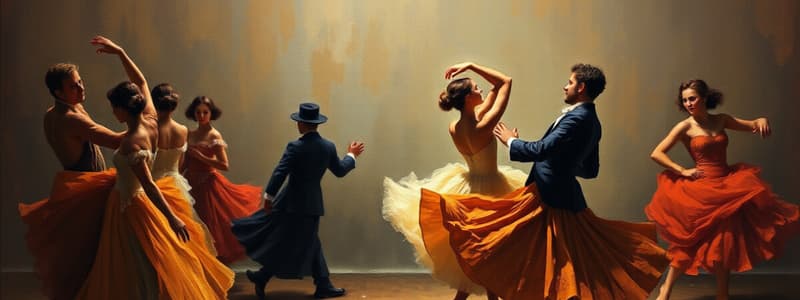Podcast
Questions and Answers
What are the primary reasons for dance?
What are the primary reasons for dance?
- To please gods (correct)
- To please themselves or self-expression (correct)
- To build community within ethnic groups or social interaction (correct)
- To please others (correct)
What does the Greek word 'damson' mean?
What does the Greek word 'damson' mean?
To stretch or drag
Dance became less important as Ancient Rome grew wealthy and powerful.
Dance became less important as Ancient Rome grew wealthy and powerful.
True (A)
In ancient Greece, dance was taught as an aid to which group?
In ancient Greece, dance was taught as an aid to which group?
Which of the following is NOT a basic type of dancing mentioned?
Which of the following is NOT a basic type of dancing mentioned?
What type of dance is characterized by dancers holding each other by hand in a circle?
What type of dance is characterized by dancers holding each other by hand in a circle?
What are some benefits of dance?
What are some benefits of dance?
Dance can be used as a means of _____ and communication.
Dance can be used as a means of _____ and communication.
Match the following types of dance with their descriptions:
Match the following types of dance with their descriptions:
Flashcards are hidden until you start studying
Study Notes
Definition and Purpose of Dance
- Dance is a multifaceted activity serving various needs: recreation, entertainment, therapy, and religion.
- It is recognized as an art form, emphasizing body movement to create aesthetic experiences.
- Main reasons for dancing:
- To please gods
- To please others
- For self-expression
- To foster community within ethnic groups and promote social interaction
Historical Overview of Dance
- Derived from the Greek word "damson," meaning to stretch or drag.
- Prehistoric dance played a vital role in religious rituals, tribal unity, courtship, and communication.
- Ancient Egypt saw the evolution of dance, documented through paintings and hieroglyphs, predominantly within religious contexts.
- In Ancient Greece, dance was integral to military training and education, valued by philosophers like Plato, who highlights its role in integrating body and soul.
- Aristotle categorized dance into noble (fine and honorable) and ignoble (clumsy or ugly).
Shadow of Ancient Rome
- As the Roman Empire prospered, dance lost value, leading to sensationalized forms involving slaves and captives.
- Early Christians condemned dance, shifting focus to preserving dance in religious ceremonies during the Dark and Early Middle Ages.
- Emergence of social dancing with peasants performing round and couple dances; nobles preferred ballroom dances.
Types and Forms of Dance
- Basic dance types:
- Round dance: involves dancers holding hands in a circle or line.
- Couple dance: initially controversial, later accepted in court settings.
- The rise of ballet during the 15th and 16th centuries marked a significant shift in dance history.
Dance in the Philippines
- Occupational dance reflects daily life and work activities.
- Religious/ceremonial dances are pivotal for rituals.
- Comic dances provide entertainment through humor.
- Game dances incorporate playful elements.
- Wedding dances celebrate matrimonial events.
- Festival dances showcase community culture accompanied by percussion instruments.
- War dances depict combat scenarios.
Elements of Dance
- Body: focus on symmetrical, asymmetrical shapes, body parts, base, and overall body shape while dancing.
- Energy: types include sustained (smooth, flowing), percussive (sharp, explosive), vibratory (trembling), swinging (curved movements), suspended (hovering), and collapsing (gravity-driven descent).
- Space: refers to the area where movements occur.
- Time: denotes timing and rhythm of movements.
Benefits of Dance
-
Physical:
- Enhances cardiovascular and muscular endurance.
- Improves coordination, balance, flexibility, and body composition.
- Reduces risk of cardiovascular diseases and lowers body mass index.
- Aids in lipid metabolism and helps maintain bone density, preventing osteoporosis.
-
Mental/Emotional:
- Sharpens brain function and decreases dementia and Alzheimer’s disease risk.
- Alleviates depressive symptoms and boosts self-esteem.
- Allows release of emotional and physical tension.
-
Social:
- Fosters a sense of togetherness and positive interactions within groups.
- Supports individual self-actualization and personal growth.
Studying That Suits You
Use AI to generate personalized quizzes and flashcards to suit your learning preferences.




